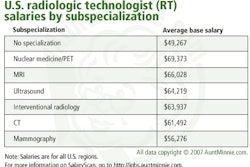What differentiates a great radiology practice from an average one? It's not the professional expertise of the radiologists.
A great radiology practice is built upon the foundation of a strong business structure and excellent governance, according to Dr. Lawrence Muroff, president and CEO of radiology consulting service Imaging Consultants of Tampa, FL. Successful practices have developed and implemented an effective mission statement and a well-constructed business plan, and adhere to established policies and procedures. They also share a culture of communication and active participation by all partners in nurturing and building the practice.
Muroff identified 12 characteristics found in outstanding group practices in the U.S. in a presentation at the 2007 Radiology Summit of the Radiology Business Management Association (RBMA), held in St. Louis earlier this month.
The 12 habits of highly successful radiology groups include the following.
Create a mission statement. A practice is defined by a mission statement, Muroff believes. This defines what a practice is, what it wants to achieve, and where it wants to implement its achievements. A mission statement provides the outline from which a business plan is developed.
Follow a business plan. A business plan defines specific goals, a strategy for implementation, and a timeline for completion. It provides a way to hold radiologists and staff accountable and to measure accomplishments. It provides guidance to the appointed leaders of the practice.
A meaningful, well-constructed business plan should be administered by a strong leader and small, proactive committees overseeing operations, finance, and marketing. Every partner -- or in academic institutions, every faculty member -- should endorse majority-approved plans, projects, and priorities.
"A very insidious problem in radiology is that the interest of individuals may supersede the group interest," Muroff said. "If I'm a senior partner who is going to retire in a year, and the group is discussing an investment of $2 million to open a new office across town, I'm not going to raise my hand and say, 'I won't see any benefit in this investment.' Rather, I will say, 'Let's not be hasty. We need to be more deliberative in this important decision.' A business plan tied to a mission statement that includes expansion will prevent the interest of individuals from severely impeding the progress of the group."
Based on his experience, Muroff said that most radiology groups fail through inaction. They are unable to make timely decisions. "A radiology group meeting is like a soap opera. You can be hit by a train, go into a coma for three years, and when you come back to the practice, the topics of the meetings are still the same."
Practice strong governance. The key to good business is strong governance. Expertise and involvement by practice managers is necessary to make a practice thrive.
Muroff believes that most radiologists prefer to avoid the business aspect of their profession, and do not recognize that the ability to lead effectively is a valued skill set. For this reason, many practices rotate the positions of group practice president and chairmanship of the hospital radiology department among their partners.
Muroff does not advocate this. He recommends that only radiologists with excellent leadership and communication skills occupy these positions for an extended period of time, as long as they are effective in the position. The more tenured the chair of the hospital radiology department is in the hospital's executive committee, the more influence the radiology practice will have. Capital budgets are developed and turf decisions are made in a hospital's executive committee, and a long-standing committee member can serve as a leader to committee colleagues whose positions force them to rotate.
Learning how to do the job of a group's president well can take several years, and if a hospital administrator disagrees with a radiology practice president who will be replaced in two years, the administrator may sit the president out until he or she is replaced by another partner.
Radiologists do not appreciate the value of time spent on administration. Members of the best radiology practices understand this and allocate the workload and time for their colleagues in leadership positions. Radiologists need to remember that practice management is not an extracurricular activity.
Confront problems. Problematic partners or associates must be confronted and dealt with, not ignored. The president of the practice needs to take action if a breach of contract occurs. Contracts exist for the benefit of a group, not the benefit of an individual, and all partners need to sign them. Radiologists who are detrimental to the practice can and should be fired.
Policies and procedures need to be established and enforced. These define expectations and provide a framework of fairness. Without policies in place, a group is dealing with a person, not a problem, Muroff believes.
In addition, consequences need to be relevant. A $100 fine is not meaningful to a radiologist. Losing a week of vacation or being given an extra weekend on call is meaningful.
As long as a radiologist is professionally competent, malpractice is part of doing business. Putting the group in legal jeopardy for other activities, such as sexual harassment, is not. Practices are adding clauses to contracts that mandate repayment by an individual for any action that generates expenses not approved by the group. Contracts should also specify that stock in the practice can only be bought and sold within the group to prevent the vulnerability of ownership by outsiders caused by a partner's bankruptcy or death.
Build the practice. All practice shareholders need to contribute to practice building. In addition to working on internal committees, practice building includes serving on hospital committees, attending the county medical society meeting, participating in the state radiological society, entertaining referring physicians, involvement in nonprofit organizational activities relevant to the practice, and speaking at local patient-oriented events. Responsibilities should be matched to the strengths of each member.
"Too often, 90% of the practice building is done by 10% of its members," Muroff said. "This is unfair and unwise. Radiology is the only profession that requires an associate to stay reasonably competent for two years before offering them a partnership. Too many young radiologists have the mentality that their responsibilities when hired are only to interpret exams. If this is all they want to do, they should be hired as an employee."
Conduct performance evaluations. The clinical and professional performance of all members of a practice should be evaluated on an annual basis. In situations in which a radiologist is considered deficient, this should be an exercise in education and rehabilitation, with stated goals to correct each deficiency.
Hire an experienced business manager. Many practices hire a professional business manager to run the business infrastructure. (In small practices, an experienced radiology administrator may provide this function.) The responsibility of this individual, working with the group's president, is to manage the operation of the business, implement the strategic plan, and maintain the fiscal health of the practice. But the hiring of a credentialed business executive does not alleviate the responsibilities of practice members from active participation.
Learn from mistakes. The best practices learn from mistakes -- move on and do not repeat them.
Stick with decisions. The best practices make decisions and stick with them. Once a decision is made, every member of the group needs to adhere to it and keep personal opinions private.
Provide quality service. Radiology is a service specialty. The success of a practice is inherently associated with the level of service provided to hospitals, referring physicians, and patients.
Market the practice. Proactive marketing is important, not just to the usual referring physicians but to managed care companies, insurance providers, other radiology practices, chiropractors, podiatrists, sports medicine professionals, massage therapists, and medical support groups. A radiologist who markets the practice is more impressive to clinical professionals than a staff member with a degree in marketing.
Face challenges. Great practices have challenges that all practices face. Because they are well-managed, successful practices are better able to cope with the challenges.
By Cynthia Keen
AuntMinnie.com contributing writer
June 4, 2007
Related Reading
Governance means enabling practice policy, not coddling personalities, March 2, 2007
Strategic planning. How to turn 'Kumbaya' into a communication event, February 13, 2007
IT governance in healthcare still evolving, August 5, 2005
Copyright © 2007 AuntMinnie.com



















